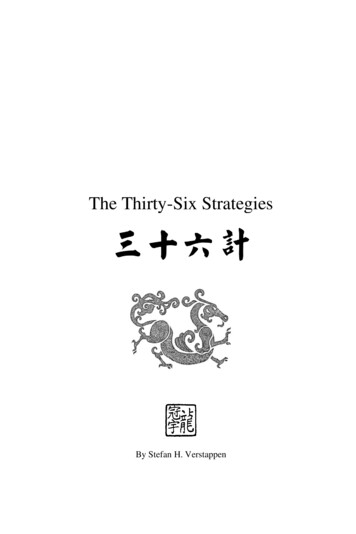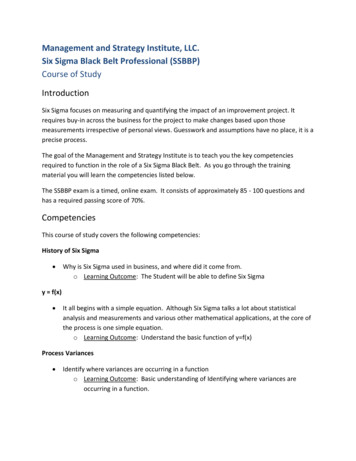
Transcription
The Thirty-Six StrategiesBy Stefan H. Verstappen
Cover Design: S. VerstappenAll Illustrations by S. VerstappenCopyright 2017 by Stefan H. VerstappenAll rights reservedCopyright 1999 byStefan H.VerstappenFirst Edition Published byChina Books, SF 1999ISBN - 978-1-365-55430-8Toronto, Canada
The Thirty-Six Strategies
Table of ContentsIntroduction . 1Strategy 1 Fool the Emperor to Cross the Sea. 5Strategy 2 Besiege Wei to Rescue Zhao. 11Strategy 3 Kill With a Borrowed Sword . 17Strategy 4 Await the Exhausted Enemy at Your Ease . 21Strategy 5 Loot a Burning House . 25Strategy 6 Clamor in the East, Attack in the West . 29Strategy 7 Create Something from Nothing . 33Strategy 8 Openly Repair the Walkway, Secretly March to Chencang . 37Strategy 9 Observe the Fire on the Opposite Shore . 43Strategy 10 Hide Your Dagger Behind A Smile . 47Strategy 11 Sacrifice the Plum Tree in Place of the Peach . 51Strategy 12 Seize the Opportunity to Lead a Sheep Away . 55Strategy 13 Beat the Grass to Startle the Snake . 61Strategy 14 Borrow a Corpse to Raise the Spirit . 65Strategy 15 Lure the Tiger Down the Mountain . 71Strategy 16 To Catch Something, First Let It Go . 75Strategy 17 Toss Out A Brick To Attract Jade . 79Strategy 18 To Catch The Bandits First Capture Their Leader . 83Strategy 19 Steal the Firewood From Under the Pot . 89Strategy 20 Trouble the Water to Catch the Fish . 95
Strategy 21 Shed Your Skin Like The Golden Cicada .99Strategy 22 Shut the Door to Catch the Thief .105Strategy 23 Befriend A Distant Enemy To Attack One Nearby .109Strategy 24 Borrow The Road To Conquer Guo .113Strategy 25 Replace The Beams With Rotten Timbers .117Strategy 26 Point At The Mulberry But Curse The Locust Tree .123Strategy 27 Feign Madness, But Keep Your Balance .129Strategy 28 Lure Your Enemy Onto The Roof, Then Take Away TheLadder.135Strategy 29 Tie Silk Blossoms To The Dead Tree .141Strategy 30 Exchange The Role Of Guest For That Of Host .147Strategy 31 The Strategy Of Beautiful Women .155Strategy 32 The Strategy Of Open City Gates .161Strategy 33 The Strategy Of Sowing Discord .165Strategy 34 The Strategy Of Injuring Yourself .171Strategy 35 The Strategy Of Combining Tactics .175Strategy 36 If All Else Fails, Retreat .181Chronological Tables .185Bibliography .187Index .195About the Author .199
IntroductionIntroductionThe Thirty-Six Strategies is a unique collection of ancient Chineseproverbs that describe some of the most cunning and subtle war tacticsever devised.Whereas other Chinese military texts such as Sun Zi's The Art Of Warfocus on military organization, leadership, and battlefield tactics, theThirty-Six Strategies are more suitably applied in the fields of politics,diplomacy, and espionage.These proverbs describe not only battlefield strategies, but tactics usedin psychological warfare to undermine both the enemy's will to fightand his sanity. Tactics such as the 'double cross,' the 'frame job,' and the'bait and switch,' can be traced back through thousands of years ofChinese history to such proverbs as Hide the Dagger Behind a Smile,Kill With a Borrowed Sword, and Toss Out a Brick to Attract Jade,respectively.Though other Chinese military works of strategy have at least paid lipservice to the Confucian notion of honor, the Thirty-Six Strategiesmake no pretense of being anything but ruthless.For the Western reader the Thirty-Six Strategies offers timeless insightsinto the workings of human nature under conditions of extreme stress.1
The Thirty-Six Strategies of Ancient China - S. H. VerstappenMany of the proverbs are based on events that occurred during China'sWarring States Period (403-221 B.C.). This was a time so infamousthat a later emperor banned history books of that era on the groundsthat they contained accounts of such a devious nature, they wouldmorally corrupt all who read them. Many of those accounts arepresented here along with the exploits of some of the Orient's greatestgenerals, kings, emperors, and shoguns.Over 118 anecdotes are included to both explain and offer examples ofeach strategy's application. By learning from the old masters of the artof deception, one is better able to spot the modern pretenders, for,though the players come and go, the game remains the same.History of the Thirty-Six StrategiesThe origin of the Thirty-Six Strategies are unknown. No author orcompiler has ever been mentioned, and no date as to when it may havebeen written has been ascertained.The first historical mention of the Thirty-Six Strategies dates back tothe Southern Qi dynasty (A.D. 489-537) where it is mentioned in theNan Qi Shi (History of the Southern Chi Dynasty). It briefly records,"Of the 36 stratagems of Master Tan, running away is the best."Master Tan may be the famous General Tan Daoji (d. A.D. 436), butthere is no evidence to either prove or disprove his authorship. Whilethis is the first recorded mention of Thirty-Six Strategies, some of theproverbs themselves are based on events that occurred up to sevenhundred years earlier. For example, the strategy Openly Repair theWalkway, Secretly March to Chencang is based on a tactic allegedlyused by the founder of the Han dynasty, Gaozu, to escape from Sichuanin 223 B.C.The strategy Besiege Wei to Rescue Zhao is named after an incidentthat took place even earlier, in 352 B.C., and is attributed to the famousstrategist Sun Bin.All modern versions of the Thirty-Six Strategies are derived from atattered book discovered at a roadside vendor's stall in Sichuan in 1941.2
IntroductionIt turned out to be a reprint of an earlier book dating back to the lateMing or early Qing dynasty entitled, The Secret Art Of War, TheThirty-Six Strategies. There was no mention of who the authors orcompilers were or when it was originally published. A reprint was firstpublished for the public in Beijing in 1979. Since then several Chineseand English language versions have been published in China, HongKong, and Taiwan.Without any other information, current speculations about the origin ofthe Thirty-Six Strategies suggest that there was no single author. Morelikely, the book derived from a collection of idiomatic expressionstaken from popular Chinese folklore, history, and myths.They may have first been recorded by General Tan and handed downverbally or in manuscript form for centuries. It is believed thatsometime in the early Qing dynasty some enterprising editor collectedthem and published them in the form that comes down to us today.Notes on the TextThe original text of The Secret Art of War, The Thirty-Six Strategies israther short, comprising only 138 Chinese characters. It merely nameseach strategy followed by a brief explanation. The book was dividedinto six categories of six strategies each. The six categories are said tocorrespond to six situations as follows: Stratagems when in a superiorposition; Stratagems for confrontation; Stratagems for attack;Stratagems for confused situations; Stratagems for gaining ground; andStratagems for desperate situations.This division is based on the hexagrams of the I-Ching (a hexagrambeing a grouping of six broken or unbroken lines). In addition, theexplanation of each strategy is likewise said to be based on theinterpretation of each hexagram as found in the I-Ching.Initially all this seemed to imply an almost scientific approach, but oncloser examination I found the structure flawed. My guess is thatelements of I-Ching numerology were added at some time merely tocreate an aura of mystery and antiquity (not an uncommon practiceamong publishers during the Ming and Qing dynasties). Since the sixsubtitles did little to improve understanding, I did not use them in3
The Thirty-Six Strategies of Ancient China - S. H. Verstappencompiling the present text, but kept to the original sequence ofstrategies.I used anecdotes primarily from both China's and Japan's 'WarringStates' eras, since, though separated by more than a thousand years,those eras most closely reflected the tone of the strategies. Myapologies to serious scholars for I rewrote the explanations andhistorical anecdotes so that they would be clearer to Western readers.Any mistakes and errors are my own. I also added opening quotes fromother Oriental works on strategy, and a summary. The resultantmanuscript is not a direct translation, nor a list of historical facts, butrather a retelling of Chinese folklore, or more specifically military lore.4
Strategy 1 -Fool the Emperor To Cross the SeaMán Tiān Guò HǎiStrategy 1Fool the Emperor to Cross the SeaIn conflicts that involve large numbers of people, it ispossible to get the opponent to become lax in their guard.When they are in a state of agitation and show signs ofimpatience, appear as if nothing is bothering you and putforth an easygoing, relaxed stance.When you perceive that the mood has been transferred (toyour opponent), you have a chance to achieve victory bymaking a strong attack with as much speed as possible.Miyamoto Musashi, The Book of Five RingsMoving about in the darkness and shadows, occupying isolated places,or hiding behind screens will only attract suspicious attention. To lower5
The Thirty-Six Strategies of Ancient China - S. H. Verstappenan enemy's guard you must act in the open, hiding your true intentionsunder the guise of common every day activities.1Warring States Period ChinaIn 225 B.C. the state of Qin, having slowly increased its power over thepast hundred years, now felt powerful enough to overcome itsremaining opponents in open aggression. The most powerful of theremaining states was Chu.The king of Qin sent his renowned general Wang Jian to attack andconquer Chu. A year earlier Qin had sent another general, Li Xing, whosuffered a humiliating defeat at the hands of Chu.The older and more experienced general Wang Jian wasn't going tomake the same mistake as his predecessor and decided against invadingthe country directly. Instead, he stopped just inside Qin's border withChu and built a fortified stockade. The king of Chu called upon hisallies to muster all available troops and rush them to the opposite sideof the border.Confident from their previous victory, the Chu commanders rode outeach day to challenge Wang to come out and fight, but Wang ignoredthe taunts. Instead, Wang was observed swimming with his men innearby rivers and lakes, or on leisurely picnics in the forest. At nightthere was feasting with singing and dancing. In addition, Wang focusedhis efforts on improving the morale and training of his troops.1 The origin of this strategy is said to come from an incident involving theTang Dynasty emperor Tai Zhong. The emperor was on campaign against theKoreans. His grneral advised crossing the Yellow Sea to the KoreanPenninsula so that they would be able to surprise the Koreans from behindtheir lines. The plan had only one flaw - the emperor deathly afraid of largebodies of water. The generals divised a scheme where the decorated a largeship like a country estate and had banners hung all roundso that you could notsee the ocean. Then theytold the emperor that a local aristocrat cordiallyinvited the emperor to dine at his estate. Oncce aboard, the emperor was dinedand entertained throughout the night while the ship silently set sail. The nextmorning they arrived at their destination with the emperor none the wiser.6
Strategy 1 -Fool the Emperor To Cross the SeaAfter several months, the Chu army was beginning to grow weary ofthe game. One of the Chu commanders said, "Wang Jian has been sentto attack Chu, but it seems he is getting too old and he no longer hasthe heart for it. It is obvious that he has no intention of attacking, but ishere merely to save face." Others agreed and many of the troops weresent back to their countries.Wang Jian had waited behind his stockade almost an entire year beforethe last of the Chu troops also gave up waiting for his attack and brokecamp to return to the capital. It was then that Wang ordered his men tosuddenly sally forth and attack the retreating Chu. Because a retreatingarmy is vulnerable to attack, coupled with the element of surprise, theChu suffered severe losses and its general was slain.The king of Chu wasn't able to reassemble all his remaining troops intime, as Wang Jian swiftly invaded and conquered the entire kingdom.Four years later the king of Qin became the first emperor of China, QinShihuangdi.Warring States Period ChinaGeneral Li Mu was given the command responsible for defendingYanmen against the Xiongnu (Nomadic horsemen that occupied thecentral Asian steppes to the north and west of China.) who wereconstantly raiding the territories.When Li Mu first arrived at his new command, everyone expected himto begin by launching attacks on the local tribes. But he did no suchthing. Instead, he focused his efforts on training and nurturing theborder troops, ensuring they were well fed and paid. He further orderedthat, should the Xiongnu attack, all troops were to retreat into one ofthe fortified towns that were scattered throughout the countryside andmerely defend. Under no circumstances were they to engage the enemy.For years, anytime a Xiongnu raiding party entered the territory theyfound the people and soldiers already holed-up behind defensive wallswith precious little left in the countryside to plunder. Eventually theXiongnu and even Li Mu's own soldiers thought that, though he was avirtuous commander, he was also a coward. The border troops, afteryears of training without engaging in battle, became restless for combat.7
The Thirty-Six Strategies of Ancient China - S. H. VerstappenWhen Li Mu saw the eagerness for battle amongst his troops, hedecided to act. First, he sent his best troops to set up an ambush severaldays march away. Then he had herds of cattle and their drivers releasedto graze in the fields with only a few soldiers to watch over them.When a Xiongnu raiding party happened upon the cattle, they attackedand sent the soldiers fleeing. The raiding party sent word back to theirKhan that the Chinese had abandoned the country leaving herds ofcattle and lightly defended villages behind.The Khan raised a tremendous host to invade the Chinese territory.Expecting no resistance from the 'cowardly' Li Mu, they were easily ledinto the ambush. More than a hundred thousand Xiongnu horsemenwere killed. For ten years thereafter, not a single raiding party daredcross the border.Japanese Folk TaleThere once lived a samurai who was plagued by a large and clever ratwho had the run of the house. This annoyed the samurai to no end so hewent to the village to buy a cat. A street vendor sold him a cat that hesaid would catch the rat, and indeed the cat looked trim and fit. But therat was even quicker than the cat and after a week with no success thesamurai returned the cat. This time the vendor pulled out a large andgrizzled cat and guaranteed that no rat could escape this master mouser.The rat knew enough to stay clear of this tough alley cat, but when thecat slept, the rat ran about. Half the day the rat would hide, but theother half he again had the run of the place. The samurai brought thecat back to the vendor who shook his head in despair saying he hadgiven the samurai his best cat and there was nothing more he could do.Returning home with his money, the samurai happened upon a monkand sought his advice. After hearing the samurai's story the monkoffered him the services of the cat that lived in the temple. The cat wasold and fat and he scarcely seemed to notice when he was carried awayby the doubtful samurai.For two weeks, the cat did little more than sleep all day and night. Thesamurai wanted to give the cat back to the temple but the monk insisted8
Strategy 1 -Fool the Emperor To Cross the Seahe keep him a while longer assuring him the rat's days were close to anend.The rat became accustomed to the presence of the lazy old cat and wassoon up to his old tricks even, on occasion, brazenly dancing aroundthe old cat as he slept. Then one day, as the rat went about his businesswithout any concern, he passed close by the cat who swiftly struck outhis paw and pinned the rat to the floor.The rat died instantly.SummaryIn battle, the element of surprise is paramount. A wary opponent isunlikely to fall into the usual traps, so he must first be made to relax hisvigilance. To do this one must carry on as though nothing untowardwas afoot.Once acclimatized to often repeated actions, a person no longer takesnotice of them.2 When the enemy ceases to pay attention to you, thetime is right to attack.2 In psychology this phenominom is known as habituation; the more often youare exposed to a stimulation, the less sensitive you become to it.9
The Thirty-Six Strategies of Ancient China - S. H. Verstappen10
Besiege Wei to Rescue ZhaoWéi Wèi Jiù ZhàoStrategy 2Besiege Wei to Rescue ZhaoAttack where he is unprepared, appear where unexpected.Sun Zi, The art of WarWhen the enemy is too strong to attack directly, then attack somethinghe holds dear. Know that in all things he cannot be superior.Somewhere there is a gap in the armor, a weakness that can be attackedinstead. If the enemy is on campaign, his home defense will be weak, ifhis army is fast, his baggage trains will be slow, if the army wellequipped, the treasury will be at a loss. 33 During the incessant fueding between the various kingdoms of the WarringStates period, any kingdom that attacked another was in danger of beingattacked by a third kingdom from the rear. This strategy was used to maintaina certain degree of military status quo. If any one kingdom attacked another,the rest would sit back and watch the outcome. But if it looked like onekingdom was becoming too powerful, the other states would unite to cut the11
The Thirty-Six Strategies of Ancient China - S. H. VerstappenWarring States Period ChinaThis strategy derives its name from a famous incident that occurred in354 B.C. At this time one of China's most renowned strategists, SunBin, (a descendent of Sun Zi) was an advisor to the king of Qi. Sun hadearlier been at the court of Wei, but another minister, Pang Juan,became jealous of Sun's cleverness. Through court intrigues, he hadSun framed as a spy, sentenced to mutilation, and imprisoned. Sunescaped (see Chapter 27) and fled to Qi.Several years later, the king of Wei appointed the same Pang Juan ascommander of the army and sent him to attack the capital of Zhao. Theking of Zhao immediately appealed to Qi for help.The king of Qi consulted his advisors who all spoke in favor of rushingto aid their ally, only Sun Bin recommended against attacking.Sun advised, "To intervene between two warring armies is like trying todivert a tidal wave by standing in its path. It would be better to waituntil both armies have worn themselves out."The king agreed to wait. The siege of Zhao had lasted more than a yearwhen Sun Bin decided the time was ripe to come to Zhao's aid. Theking of Qi appointed Prince Tian Ji as general and Sun as militaryadvisor.Tian Ji wanted to attack the Wei forces directly to lift the siege of Zhao,but again Sun advised against direct intervention saying, "Since most ofWei's troops are out of the country engaged in the siege, their owndefense must be weak. By attacking the capital of Wei, we will force thearmy to return to defend their own capital thereby lifting the siege ofZhao while destroying the Wei forces in turn."ambitious state down to size. This went on for several hundred years, but inthe end, the Warring States rulers neglected this strategy and the kingdom ofQin was finally able to conquer all of China.12
Besiege Wei to Rescue ZhaoTian Ji agreed to the plan and divided his army into two parts, one toattack the capital of Wei, and the other to prepare an ambush along theroute to the capital.When the Wei general Pang Juan heard that the capital was beingattacked, he rushed his army back to its defense. Weakened andexhausted from the year-long siege and the forced march, the Weitroops were completely caught by surprise in the ambush and sufferedheavy losses.Zhao was thus rescued while Pang Juan barely escaped back to Wei torecoup his losses. Sun Bin would later defeat his nemesis Pang Juanusing another classic strategy (see Chapter 28)Han Dynasty ChinaAfter having defeated Wei, the Han general, Han Xin, led his armythrough the Jing River gorge to subdue Zhao. The king of Zhao in turnmobilized his army and set up fortified positions just in front of themouth of the gorge where the Han army would have to exit.Han Xin, knowing the most logical place for an ambush would be at theexit, halted his army some thirty Li 4 from the mouth.During the night, Han Xin ordered two thousand of his light cavalry tomuffle their horse's hooves and secretly make their way throughunderbrush to set up an observation post overlooking the enemy'sencampment. Each man was furthermore instructed to carry a red flag.Han Xin told his commanders, "When the Zhao forces see me marchout, they are sure to abandon their fortifications and come in pursuit.Then you must enter their walls with all speed, tear down the Zhaoflags, and set up the red flags of Han instead."The next day Han Xin ordered the main body of his army to line upwith their backs against the river. When the Zhao troops saw this theyrejoiced in their assured victory since it was a well- known rule of warto never fight with water at your back.4 One li equals approximately 0.3 miles.13
The Thirty-Six Strategies of Ancient China - S. H. VerstappenHan Xin moved first, launching an attack against the Zhao positions.After a while the Han feigned a retreat and fled back to the main bodystill lined up along the river. The Zhao forces, feeling confident in theiradvantage of terrain and superior numbers, pursued the Han to the riverwhere they engaged in a fierce battle.As Han Xin had anticipated, the Zhao forces completely abandonedtheir camp leaving only a handful of soldiers behind. When the Hancavalrymen hiding in the mountains saw the Zhao army deserting theircamp, they knew the time had come.They charged down the mountain, entered the compound and quicklykilled the remaining Zhao guards. Then they tore down the Zhaobanners and replaced them with the red flags of Han.Meanwhile, the Zhao forces were unable to gain any advantage in thedesperate fighting along the river, and so were about to retreat to theircamp when they saw the Han flags flying behind the ramparts.The Zhao soldiers, believing that the Han had already captured theirleaders, panicked and fled in all directions to escape.The Han then closed in from both the river and the camp to attack ontwo fronts, inflicting a severe defeat and capturing the king of Zhao.Warring States Period ChinaDuke Wen of Qin had decided to invade Wei, so he called in the feudalnobles to lay out his plans for attack. However, he was interrupted bythe laughter coming from one of the nobles named Kong Zichu."May I ask the source of your amusement?" asked the duke."I was laughing at a man in my neighborhood and some gossip Iheard," replied Kong. "It seems one day he was walking home with hiswife when he spotted a lovely maiden gathering mulberry leaves by theroadside. No sooner did he escape his wife to go flirt with the girl when,upon turning around, he saw another man making love to his wife. Iwas just thinking about the story and I couldn't help but laugh."14
Besiege Wei to Rescue ZhaoSeeing the moral of this story Duke Wen canceled his invasion plansand recalled his army from its march. No sooner had the Qin armyreturned when they were sent out to stop an invasion on their ownnorthern border by an unexpected enemy.SummaryTo confront a powerful opponent in a head-to-head contest of strengthis the most costly and least favorable method of war. Instead, while theenemy is preoccupied with other objectives you attack something ofvalue that he has left behind unguarded. When he is forced to break offhis current campaign in order to rescue what he has lost, you can leadhis disheartened forces into a trap.15
The Thirty-Six Strategies of Ancient China - S. H. Verstappen16
Kill With A Borrowed SwordJiè Dāo Shā RénStrategy 3Kill With a Borrowed SwordIf you are limited in your own strength, then borrow thestrength of the enemy. If you cannot neutralize an enemy,borrow an enemy's knife to do so. If you have no generals,borrow those of the enemy.Sun Zi, The Art of WarWhen you do not have the means to attack your enemy directly, thenattack using the strength of another. Trick an ally into attacking him,bribe an official to turn traitor, or use the enemy's own strength againsthim.Spring And Autumn Period ChinaThe duke of Zheng wanted to invade the state of Kuai. To prepare forhis invasion he first sent out spies to find out who were the mostcapable military advisors at the Kuai court.17
The Thirty-Six Strategies of Ancient China - S. H. VerstappenOnce he had a list of names, the duke had a rumour spread among histroops saying that victory was assured since he had Kuai's best generalssecretly on his side.He also had a decree drawn up promising these generals that, once hehad conquered Kuai, they would all be richly rewarded with titles andterritories. To back up his promise he had the decree enshrined in alocal temple were everyone could see it.Naturally the king of Kuai had spies in Zheng's army and they reportedthe names of the alleged treacherous generals to the king. Believing histrusted advisors were preparing to betray him, the king of Kuai hadthem all executed.When the duke of Zheng heard of the executions, he launched hisattack. The king of Kuai became alarmed at the sudden invasion of histerritory and called his army staff together to mount a counter attack.But the recent executions had eliminated all his capable leaders. Theremaining junior officers were inexperienced and unsure of how torespond. Their hesitation cost the king his throne, and his head.Warring States Period ChinaChang Tuo defected from Western Zhou and went to Eastern Zhouwhere he revealed all of Western Zhou's state secrets. Eastern Zhourejoiced while Western Zhou was furious.Minister Feng Chu said to the king of Western Zhou, "I can assassinatethat man if your highness will give me thirty catties of gold."The king consented and the next day Feng Chu sent an agent to theEastern Zhou court bearing the gold and a letter addressed to ChangTuo.The letter read, "This is to remind Chang Tuo that you must completeyour mission as soon as possible, for the longer the delay the morelikely you will be found out."18
Kill With A Borrowed SwordHowever, before the first agent departed, Feng Chu sent another agentto the Eastern Zhou border guards informing them that a spy would becrossing the border that night.When the first agent arrived at the border he was stopped and searched.The border guards found the gold and the letter to Chang Tuo andturned them over to their court officials. Shortly afterwards Chang Tuowas executed.Chinese Folk TaleOne day a fox was wandering through the woods preoccupied inthought when he was suddenly surprised by a tiger who seemed intenton eating him. It being too late to run away, the fox had to thinkquickly.Nonchalantly he asked, "Tiger why are you here, are you not afraid ofme?""Why should I be afraid of you?" asked the tiger."Because I am the king of the jungle," said the fox."Ridiculous!" replied the Tiger. "I am king of the jungle.""Well if you don't believe me I'll prove it. Just follow me as I walkabout the jungle and see for yourself if the other animals do not runaway at my approach."The tiger agreed and so the fox set off with the tiger following closelybehind. As the other animals spotted the fox they also saw the tiger andthey ran away.After a while the fox turned to the tiger and said, "See how they scatterwhen I approach. Do you believe me now?""It seems I was wrong," said the perplexed Tiger, and he sulked awayinto the jungle.19
The Thirty-Six Strategies of Ancient China - S. H. VerstappenSummaryTo succeed in any endeavour one must be frugal in expending one'sresources. Where possible, use trickery a
The original text of The Secret Art of War, The Thirty-Six Strategies is rather short, comprising only 138 Chinese characters. It merely names each strategy followed by a brief explanation. The book was divided into six categori










